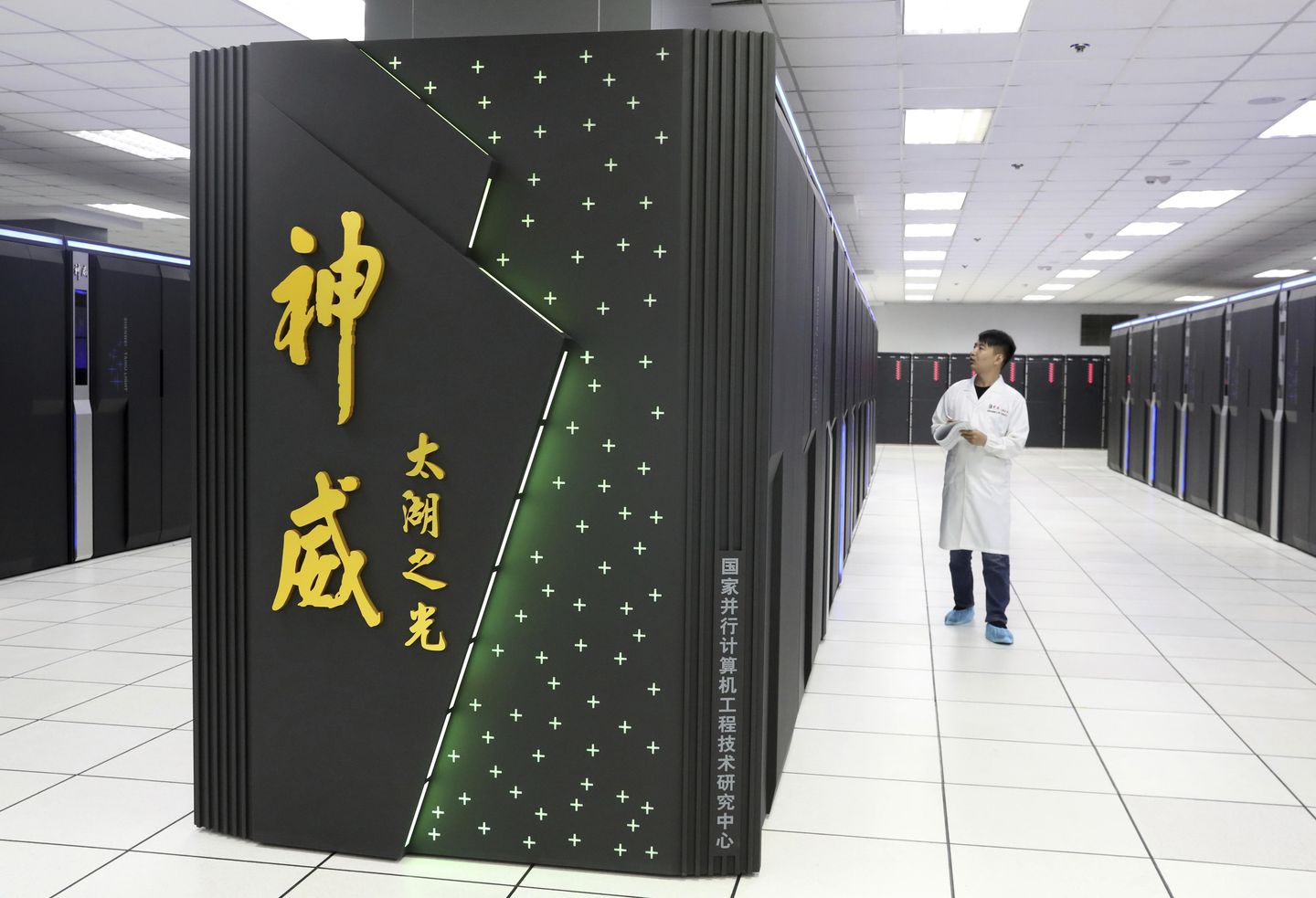
NEWS AND ANALYSIS:
U.S. national laboratories and several American universities that are engaged in Pentagon-funded research are using Chinese supercomputers in ways that endanger U.S. national security, according to a former Air Force intelligence analyst.
L.J. Eads, now a specialist on China security matters, uncovered the links in research from over 100 scientific studies between 2016 and 2024. The studies revealed that American researchers were using China’s TianHe-series supercomputers located in Tianjin and Guangzhou.
The systems are part of the Chinese national supercomputer center and were used in papers produced by researchers at Argonne, Oak Ridge and Los Alamos National Laboratories. The laboratories are involved in sensitive defense work, including nuclear weapons.
The supercomputer centers are linked to the People’s Liberation Army and other official Chinese ministries and institutes that are on the Commerce Department’s blacklist of foreign companies.
The systems “serve as critical infrastructure for the PLA and the Chinese Communist Party (CCP) in advancing military technology, hypersonic weapons and AI-driven defense capabilities,” Mr. Eads said.
The Guangzhou supercomputer, in particular, is a major military system that has been used to build hypersonic missiles, aerospace systems, satellite surveillance, cryptographic analysis and nuclear weapons.
The supercomputer in Tianjin has worked on PLA hypersonic propulsion systems, strategic war gaming and cyber warfare operations.
Other Chinese research using supercomputers has facilitated biomedical research and genetic analysis that could be used for weapons, and air and space research.
The systems are also engaged in work on quantum cryptography, electronic warfare simulations and counterspace operations that are key parts of Beijing’s civil-military fusion strategy.
According to Mr. Eads, 25 U.S. university research papers referenced the TianHe supercomputers and 77 papers from national laboratories involved Chinese supercomputers.
“The involvement of supercomputers known for their military affiliations in China raises significant security concerns about the inadvertent transfer of sensitive nuclear technologies,” Mr. Eads said.
In addition to the dangers of technology theft, the use of Chinese supercomputers by U.S. researchers also increases the risk of hacking and malicious code insertion by Chinese state-run cyber actors, Mr. Eads said.
The supercomputer use also undermines U.S. sanctions enforcement and export controls aimed at limiting China’s acquisition of advanced supercomputer know-how, he said.
“By collaborating with Chinese supercomputing centers on the Department of Commerce’s Entity List, U.S. researchers effectively circumvent the restrictions designed to limit the PLA’s access to advanced computational power, undermining core U.S. foreign policy objectives,” Mr. Eads said.
Key Pentagon entities involved in the Chinese supercomputer use include the Air Force Research Laboratory, the Air Force Material Command, the Naval Research Laboratory, the Office of Naval Research, the Army Research Laboratory, the Defense Advanced Research Projects Agency and the Defense Threat Reduction Agency.
Pentagon-funded research at several prestigious universities also used Chinese supercomputers. The report listed seven examples of defense-related collaboration using Chinese supercomputers.
In one 2024 case, researchers from MIT worked with Chinese researchers at Peking University on hydrogen production techniques. The dual-use civilian and military research was funded by the Army.
Mr. Eads’ research into Chinese supercomputer use expanded on earlier reporting on the problem first disclosed by the Daily Caller News Foundation in March.
China’s military comments on Hegseth’s warning about hypersonic missile threat to carriers
China’s Defense Ministry recently praised the People’s Liberation Army’s development of hypersonic missiles that can effectively attack U.S. aircraft carriers.
The ministry commented on a report in this space about Defense Secretary Pete Hegseth’s belief that Beijing’s hypersonic missiles can knock out U.S. aircraft carriers within the first 20 minutes of a conflict.
Senior Col. Zhang Xiaogang, a ministry spokesman, was asked about the April 16 Inside the Ring column. He praised PLA hypersonic missile deployment.
Mr. Hegseth’s comments, he said, reflect efforts by the U.S. to inflate Chinese military threats.
“We have a sober understanding of the state of our development,” Col. Zhang said. “We hope the U.S. side will break away from persecution mania and stop using others as excuses.”
The spokesman said “some individuals” in the U.S. view the Chinese military with bias and are hyping the China military threat.
Col. Zhang then sought to exploit past Pentagon eagerness for military exchanges with the PLA. He said hawkish American views are an obstacle to military-to-military engagement between the U.S. and China.
“Nonconflict, nonconfrontation and peaceful coexistence is in the most fundamental interests of both China and the U.S. and meets the common expectation of people across the world,” he said.
The Pentagon’s most recent annual report on the Chinese military, published in December, stated that in 2023, “the PLA largely denied, cancelled, and ignored recurring bilateral engagements.”
Some exchanges resumed after the November 2023 summit between then-President Biden and Chinese President Xi Jinping.
Mr. Hegseth stated in a November interview — months before becoming defense secretary — that the Chinese military’s ultra-high-speed maneuvering missiles are a key element of forces being built specifically to target the American military.
“So if our whole power projection platform is aircraft carriers and the ability to project power that way strategically around the globe. And, yeah, we have a nuclear triad and all that, but [carriers are] a big part of it. And if 15 hypersonic missiles can take out our 10 aircraft carriers in the first 20 minutes of a conflict, what does that look like?” he said.
Aircraft carriers currently have limited defenses against Chinese hypersonic missiles. Anti-missile interceptors are deployed with carrier group destroyer escorts.
China has deployed two hypersonic missile systems: The DF-17 medium-range missile can be armed with a hypersonic glide vehicle, and the 5,000-mile-range DF-27 also can be armed with a hypersonic warhead.
The Pentagon is behind schedule in developing several types of hypersonic missiles in response to Chinese and Russian high-speed maneuvering missiles.
China’s political warfare revealed
China is engaged in aggressive political warfare operations against Taiwan as part of its strategy to take over the democratically ruled island nation, according to China experts Kerry K. Gershaneck and Eric Chan.
“Political warfare plays a central role in Chinese military operations,” the two experts stated in a recent journal article. “China is currently conducting a deliberate, multi-layered campaign designed to weaken Taiwan’s resolve and preempt U.S. intervention.”
The Beijing strategy involves what the Chinese military calls “three warfares” — public opinion, psychological and legal warfare.
The goal is to use influence operations, economic coercion and military intimidation to shape the strategic landscape in China’s favor.
The ruling Chinese Communist Party is trying to isolate Taiwan diplomatically, destabilize its internal politics through disinformation operations and deter foreign support through gray-zone military activities — those below the threshold of armed conflict, the China experts said.
If war breaks out across the 100-mile-wide Taiwan Strait, Chinese political warfare will intensify and target U.S. forces, alliance cohesion and domestic morale.
The overall objective is to spread the narrative that subjugating Taiwan is inevitable and that U.S. resistance is futile, they said.
To counter Chinese political warfare, the United States and Taiwan must recognize the activities as soon as possible. U.S. and Taiwan should then conduct operations to counter the coercive activities, Mr. Gershaneck and Mr. Chan stated in the current issue of the Journal of Indo-Pacific Affairs, published by the Air Force’s Air University Press.
The CCP recently stopped using references to “peaceful reunification” in its state-run media and propaganda, a significant shift from past strategy.
Chinese President Xi Jinping is now using a strategy of military coercion, a component of political warfare. This is visible in large-scale gray-zone tactics involving constant military pressure, economic coercion and disinformation, the experts said.
The campaign is designed to steadily tighten a political noose around the island.
“The scale and intensity of the CCP’s political warfare in peacetime is already unprecedented, often proving highly effective,” Mr. Gershaneck and Mr. Chan said. “In war, it will escalate even further. Given this clearly foreseeable threat, it is imperative that U.S. national security leaders incorporate political warfare considerations into operational-strategic planning.”
The article reveals how CCP political warfare was used during the COVID-19 pandemic, domestically to suppress dissent and establish CCP control over the narrative.
“In December 2019, as the virus spread in Wuhan, the local Party’s first priority was not containment but information suppression—silencing and arresting whistleblower physicians,” the authors said.
The second element saw the CCP engage in offensive political warfare to silence competing international narratives about the disease and its origin.
This was highlighted by Mr. Xi’s visit to Wuhan in March 2020 that marked the launch of a global propaganda campaign to deflect blame for pandemic mismanagement and assert the supposed superiority of the CCP’s communist system over the West.
Chinese propagandists shaped the narrative by stressing the uncertainty over the origin of COVID. This sought to counter its likely source as the Wuhan Institute of Virology.
Conspiracy theories were then spread through official state media, including the false claim that COVID-19 was introduced to Wuhan by U.S. military personnel who took part in the October 2019 Military World Games.
“By July 2021, these theories had coalesced into an official state-backed disinformation campaign, with Beijing pushing the narrative that the virus originated at the U.S. Army’s Fort Detrick research facility,” Mr. Gershaneck and Mr. Chan said.
“The CCP’s pandemic response was not just a public health crisis — it was a global case study in the CCP’s ability to manipulate perception, control information, and weaponize narratives to its advantage,” they stated.
Mr. Gershaneck is a visiting scholar at National Chengchi University in Taipei and a retired Marine with extensive experience in Asia. Mr. Chan is a senior nonresident fellow at the Global Taiwan Institute.
• Contact Bill Gertz on X @BillGertz.












